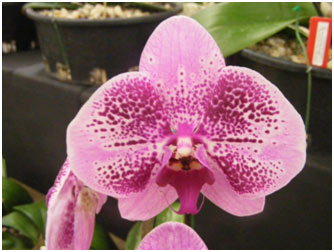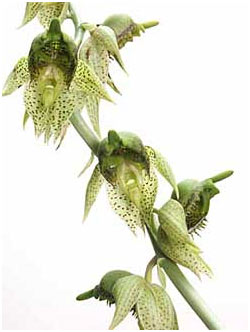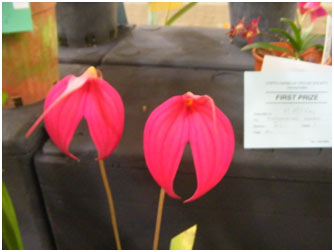Orchid News – December 2011
Home > Orchid News > 2011
Index
Calendar
- 1 Dec Christmas and awards.
- 2 Feb Ray Clements
December Meeting
The December meeting is an informal meeting where we have a few awards, our regular monthly competition and a Christmas dinner.
Members are requested to bring a plate and some drink to share. Remember that we are not able to heat food. After the awards we will clear away the plants, put tables in the middle of the room, and enjoy a Christmas dinner.
Members are also asked to bring a small gift – no more than $10 – for the secret Santa.
Committee Report
- Thanks to members for the suggestions regarding the ideas we raised at the last meeting. Committee felt that members were quite clear that we should
- Run future Spring Shows at the Botanic Gardens
- Accept mature, well-established plants for the sales table. We will try this to see how it goes.
- Keep the commission at 15% for plant sales.
We also discussed
- The future of our involvement in Botanica/Sustainable Living at the gardens.
- The need to have a “greeter” at the door for monthly meetings to hand out labels for monthly competition, popular vote, attendance book, name tags, etc.
- Thanks to Brian and Gordon for the beginners workshops
- What is the purpose of the table talk?
- We will consider ways to improve our society in 2012 – any thoughts from members would be welcome.
Office Bearers for 2012
At the AGM the following were appointed
President Ed Pearce
Vice President Steve Clemesha
Secretary Sherill Harrison
Treasurer Bruce Hall
Committee Don Turner, Sue Williams, Carole Davis
The following positions are held as indicated in this list (if any of these people don’t wish to continue could he or she please speak to Ed or one of the committee).
Show Marshall Ivy Wheeler
Asst Show Marshall Bill Bright
Editor Ed Pearce
Asst Editor Sherill Harrison
Publicity Bruce Hall
Membership Bruce Hall
Librarian Carol Davis
Public Officer Steve Clemesha
Catering Sue Williams, Barb Pearce
Raffle Plants Betty Pittaway
Raffle sales Clem Murray
Sales table ?
Monthly Comp points Gary Suter
Workshop at Gordon’s
Beginners Classes – November 6th 2011 with Brian Newman and Gordon Clarke.
Though our turnout was very small today it was a very good class to help all of us novices to know exactly what we are supposed to be doing with our orchids at this time of year.
We should be in the middle of our feeding program now so as to reap the rewards of wonderful blooms in the late summer autumn period and even for those flowering early next spring.
There was so much today it is hard to know where to start so I will jump right in.
If you have plants going well it is a time to watch for new spikes appearing to ensure they get spiked properly so if you intend to show the flowers they are facing the way to attract attention.
Keep the fertiliser up during this period. It is also ok to keep regular fertilising going even after flowering has finished to strengthen the plant again for the next season. If you are having problems getting your orchid to flower it could be any number of reasons.
It is important to find out exactly what your orchid is, where it comes from and the conditions it grows best in there. If you can replicate these than you have the conditions right. Also feeding and potting medium may have an effect, egg. If your orchid is used to growing in trees it may need mounting instead of potting.
Also if you are trialling a new fertiliser it is best to only do so on one plant at a time to minimise the risk of losing all your orchids. Also check what is in the fertiliser and it is what the plant needs. The right balance of MPK. (This has been covered in an earlier beginner’s class and notes can be sourced on the Coffs Harbour Orchids website or ask any of the more knowledgeable members of the society.
It has been recommended never to use a slow release fertiliser as this can sweat in humidity and cause a larger degree of release next time the plant is watered causing burning and overdosing to the roots.
For those who are confused by it all at this point Campbell’s Yellow is the safest bet to covering most bases of fertilising until you gain a better understanding.
Gordon makes up his own mix that he has found works very well. If you would like information on this please contact him on 6654 2553.
Now: to Re-pot and Divide.
We worked on a very crowded Cattleya today which had a number of new spikes. Gordon allowed at least 3 older stems to be included in the sections with the new spike.
Before starting this process it is important to have tools at hand to make the process easier.
This is a list of everything Gordon used:
- New squat pots with good drainage holes
- Potting mix (Gordon makes up his own. He can be contacted if you would like to make it yourself).
- Styrofoam pieces
- Wire plastic coated, clips, stakes, clippers, scissors, wire cutters, clippers.
- Labels, paintbrush, little scrubbing brush, marker pen,
- Listerine, sterilizer, metho, cotton buds, fungicide
- Gravel pebbles
- Rubbish bucket
- Bowl of warm water to soak roots to minimise damage.

Interesting colour in a Phalaenopsis.
To Re-pot
- To begin carefully remove plant from the pot Loosen from the back to the front of the plant.
- Take all the old potting mix off and loosen the roots.
- Divide where new spurs are showing allowing 3 to 4 leads with it using sterilized cutters.
- Wash the roots free of any leftover soil.
- Check for new roots and cut away old black roots using sterilized scissors (the back of the plant is where most of the old roots are found – if they feel really soft get rid of them).
- Paint the cuts with fungicide.
- Prepare your pot by affixing a wire stake (with a small circle made at the top of the wire) hooked into the bottom of the outside of the pot, at the top edge bend the wire towards the middle of the pot and attached a coated piece of wire nearly at the top of the wire. (This may need to be adjusted depending on where your plant needs to be secured). This is difficult if you want to use clay pots. Also with clay pots the roots tend to adhere to them and become difficult to remove. They also need far more watering in hotter seasons. They also hold salts which can damage your plants.
- Firstly into the pot add a layer of Styrofoam pieces, then a light layer of potting mix. Your new plant should have the Rhyzome showing above the potting mix. Spread the roots out and position the back cut end against the pot so the new spikes have plenty of room to grow out from the centre, cover with more potting mix. Finally secure the tall canes with the wire against the stake ensuring you get them all and cover the potting mix with gravel. Still remembering to make sure the Rhyzome is not covered with soil or gravel.
- Place where it will get a breeze not strong wind and put in label. If you put the label spike deep enough, lifting this should be able to tell you if your plant is in need water. Check if there is damp soil sticking to it easily.
If you would like an easy solution to attaching orchids to trees – double a piece of plastic Gutter-guard ( a length of approximately 40cim) and secure with plastic ties making sure the 4 corner ones are left as a loop to secure rope to for looping round the tree trunk. Leaving one end open. Fill with sphagnum moss and insert plant.
Be sure not to attach to palms, pines or loose barked trees. Paperbark is ok. If you get a new spur shooting cut away some of the mesh to allow it to grow without damage.
A few other fertilizers recommended are:
Carob Cal if you need to increase calcium to the soil mix. (4ml to 1lt of water)
Plantation Starter if you have new small plants that need a head start. You will need to wean them off this mix and onto your usual fertilizer as they get established. (1ml to 1lt of water).
Minutes of 2011 AGM
Meeting opened at 7:30pm
Minutes of 2010 AGM Detailed in November 2011 newsletter. Mvd by Don Turner and Sue Williams that minutes be approved
Nil Business arising from last AGM meeting
Presidents Report: Ed Pearce highlighted the main events of the year. A full report given in the November 2011 Newsletter.
Financial report: a summary was given by Bruce hall. All details published in report which was distributed at the meeting…
Mvd. Brenda Mayled Scd. Betty Pittaway. That report be approved
Motion to keep the annual fees the same as the previous year. $10 for individuals and $15 for couples.
Mvd. Bruce Hall. Scd. Sue Williams.
Election of Office Bearers
President Ed Pearce
Vice President Steve Clemesha
Secretary Sherill Harrison
Treasurer Bruce Hall
Committee Carole Davis, Don Turner, Sue Williams.
Meeting closed at 7:44pm.

A nice Tolumnia
Agenda For December Meeting
Welcome, Apologies, Visitors.
Minutes of Nov meeting – as printed in newsletter
Business Arising
Committee Report – refer to report.
Inwards Correspondence
Outwards Correspondence
Finance Report – no report.
Active Service Awards.
Table talk?
Awards for Monthly competition.
General business – nil.
Raffle, popular vote.
Minutes for November Meeting
Meeting Opened at 7:45pm
Welcome; New Members: Glenys and John Smith, Robert Standing.
Apologies: Ken & Dulcie Green/McBain, Barbara Pearce, Kay & Norm Mitchell, Ron & Judy Cowling, Margaret Chapman, Trish Rhoades,
Welcome:
Minutes of last Meeting: Mvd. Don Scd. Steve That minutes as printed be approved.
Nil Business Arising
Committee Report as printed
BUSINESS Arising – dealt with in General Business.
Correspondence: BCU Statements, Xerox (newsletter invoice), Taiwan Orchid Tour information.
Finance: Read for AGM meeting
Sponsors Spot: Fitzroy Motors
Table Talk: Gary, Tracy and Di
General Business:
- Botanica: Botanic Gardens open day 6th November 2011– Setup 8:00am to 3:30pm volunteers for the day to help with queries and also help with the plant sales. Plants needed for display and sales table. (Sales plants to be in bud or flowering).
- Attention drawn to committee report. General agreement with suggestion that we have Spring Show at Botanic Gardens and include mature, well established plants on sales table. Opposition expressed to raising the commission for plants sold from 15% to 20%. The increase was considered to help add funds to running costs of the society.
- Workshop at Gordon Clarke’s Woolgoolga Sunday 6th November.
- Xmas Meeting will be the last for the year with a similar format to the previous year. Please bring along Display flowers. Please remember that the point scoring is still in effect at this meeting.
Popular Vote:
Raffle:
Guest Speaker – Brian Newman
Brian talked to us tonight on Catasetums. Though these plants are reasonably high maintenance they are well worth it when they flower. There are over 70 species and many more hybrids of this particular orchid.

Catasetum sanguineum
To start with Brian uses Searle’s Bromeliad mix when potting up. They do not like to be over potted or over watered especially if there is no definite root structure formed. When repotting it is sometimes only necessary to remove from the old mix, clean up the roots, old stems and leaves and secure back into the same pot well cleaned with new mix and well wired.
You may find that if they had been flowering previously they may take 3 to 6 months before flowering begins again. The bud may come onto the plant but you may still have to wait quite a long time till it actually flowers. These are not a plant for the person who has little patience.
These plants love a bit of warmth/humidity and plenty of fertiliser as once roots have formed they are incredibly hungry. Brian’s shade has a double skin as he found this kept the humidity up when he misted but knocked back the heat to sustainable levels.
Water once a week during winter and make sure they are watered more frequently in summer. He finds misting 3 to 4 times a day during summer really keeps them happy especially if the weather is really hot.
Repotting is usually done every one to two years depending on growth.
They love a sheltered position with good light if you do not have an orchid house to keep them in. Things to watch out for are the prickly spikes at the top of the older buds, red spider mites, thrips, and slugs which love to divest you of any new buds and roots.
It is important not to put Styrofoam in the mix as these orchids really don’t like it. The growing period is from August onwards and Brian uses a variety of fertilisers including Dynamic lifter, Campbell’s yellow, Nitrosol.
If you have any queries at all or would like a more detailed run down on cultivating these beautiful orchids he is only a phone call away on 6654 1432. His email is briannewman@dodo.com.au.
Meeting closed at 8:45pm

Masdevallias can be difficult to grow in Coffs, but have intense colours.